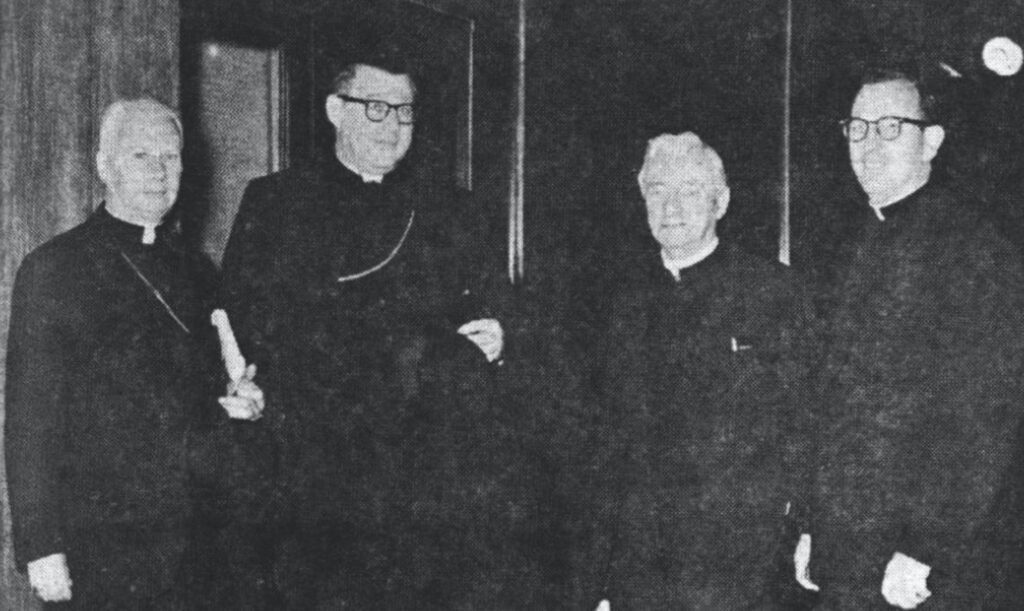VATICAN II – 1962
EMBARKING ON VATICAN II
Soon after John J. Russell was installed as the 10th bishop of Richmond (1958–1973), Pope St. John XXIII, who himself had been recently elected, shocked the world: “We announce to you, indeed trembling a little with emotion, but at the same time with humble resolution of intention… an ecumenical council for the Universal Church” (Jan. 29, 1959).
This 21st general council of the Catholic Church (1962-1965) shaped Catholicism for the next 50 years and beyond. It was called Vatican II because it was the second ecumenical council to meet in St. Peter’s Basilica in the Vatican. (Vatican I met 1869–1870. That council was suspended when the Kingdom of Italy occupied Rome during the Franco-Prussian War, and it was never formally closed. There was even speculation that the council announced by John XXIII might be a continuation of Vatican I.)
The purpose of Vatican Council II was to rejuvenate the Church in order to evangelize the modern world. As John XXIII explained, humanity had entered a new era of scientific discoveries, technological progress and greater collaboration, but also of increasing alienation from God and, consequently, dangerous political ideologies, ever more deadly wars, and a perceived lack of ultimate purpose.
John XXIII believed a renewed Church could better help people conduct their affairs according to the values and providence of God, their creator, and in that way solve these problems. Such a renewal of the Church would strengthen the holiness of its members, apply its teaching to modern issues and concerns, update its structures and practices, and work for the unity of Christians.
In Richmond, even before Vatican II got underway, Bishop Russell began to carry out the council’s stated goals. He allowed greater use of the dialogue Mass, in which the people made the responses to the priest along with the altar servers, as a way of increasing lay participation in the liturgy (1960). Richmond became only the second diocese in the United States to establish an ecumenical commission, which sought to improve relations among Christian denominations (1962).
Russell, along with other bishops, submitted suggestions (Latin: vota) for the agenda of Vatican II as part of the council’s preparatory work. His proposals included an explanation of the mission of lay people based on the sacraments of baptism and confirmation (in contrast to the mission of priests based on holy orders); a discussion of papal infallibility, which had been defined at Vatican I, with respect to secondary documents promulgated by the pope; a recommendation that priests be able to recite the Breviary, their set of official prayers, in the vernacular language, to enrich their spiritual lives and preaching; and a teaching about the morality of nuclear warfare.
Vatican II addressed most of these issues. The council’s teachings included a lengthy treatment of the mission of lay people; an explanation of the collegiality between the pope and bishops as a complement to papal infallibility; the principles of liturgical reform that included permission for some use of the vernacular; and a condemnation of the use of nuclear weapons, a warning against the arms race, and an appeal for peace.
Bishop Russell attended all four sessions of Vatican II. At the second session (1963), he made an official intervention during the debate on the document on the Church (what became “Lumen Gentium”). Russell argued that the text should mention the holiness of the Church before the calling of its members to holiness, since the faithful were also sinners. This approach was reflected in the final document.
With regard to the document on the liturgy (what became “Sacrosanctum Concilium”), which was also discussed during the second session of the council, Russell spoke on behalf of 150 bishops in favor of the recitation of the Breviary (Divine Office) in the vernacular. The final document gave bishops the authority, in individual cases, to allow to priests to pray the Breviary in the vernacular if they had a serious difficulty with Latin.
Priests could also recite these prayers in the vernacular if they did so together with a group of lay people. As part of the liturgical reform that followed the council, all priests and religious were permitted to pray the Divine Office in the vernacular.
Bishop Russell implemented the teachings and reforms of Vatican II when he returned to Richmond: liturgical changes; the promotion of the specific mission of lay people; greater collaboration between clergy and laity; increased ecumenical cooperation and interfaith dialogue; social justice, including advocacy of civil rights, which he actively supported; and later, the restoration of the permanent diaconate.

